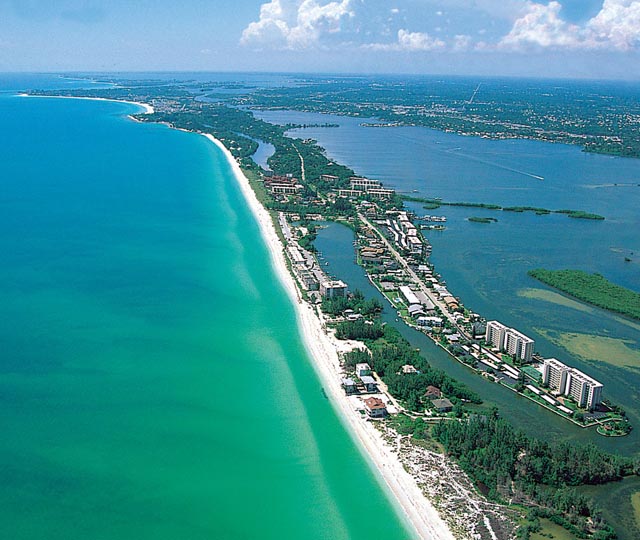
Off the coast of Sarasota, Florida is a captivating 8-mile long barrier island known as Siesta Key. Surrounded by the crystal clear waters of the Gulf of Mexico and Sarasota Bay, the Siesta Key real estate market just might be the perfect place to live or to own a second home on Florida’s waterfront.
Table of Contents
| Siesta Key Homes For Sale | History of Siesta Key | Map of Siesta Key |
| Market Statistics | Photos | Resources |
Siesta Key Homes For Sale
We're sorry, but there’s nothing to display here; MLS data service is not activated for this account.
Map of Siesta Key
Market Statistics
Photos
images not found
History of Siesta Key
Siesta Key was a sleepy, virtually uninhabited barrier island off the coast of Sarasota until early in the 20th century. In fact, the island wasn’t even called Siesta Key then. It was variously known as Clam Island, Little Sarasota Island, or Sarasota Key and was hardly a tourist destination. A few area families had built beach homes on the island and a handful of particularly hardy individuals even lived here year ‘round. Most residents were fishermen and their families, although a few orange groves had been planted on the Key and one enterprising entrepreneur had opened a fertilizer plant here as early as 1848.
Siesta Key in those days had all of the traits lush tropical sands were known for: dense vegetation and even denser mosquito swarms, snakes of all varieties (including all of the poisonous ones found in the United States – rattlesnakes, copperheads, water moccasins and coral snakes), sand fleas, mean wildcats and even meaner wild boars. The Key was not connected to the mainland and everything was transported across Sarasota Bay by boat. All of this began to change very shortly after the beginning of the 20th century. In 1906, Capt. Roberts and his wife turned their large boardinghouse home into a hotel. They offered accommodations to northern visitors for the winter and became famous for Mrs. Roberts’ seafood recipes.
Mrs. Roberts’ cooking – especially her clam chowder – was so good that her culinary prowess brought members of the Eastern establishment to Siesta Key to stay and eat at the Roberts’ Inn (also known as the Siesta Inn). Hollywood elite, including Cecil B. DeMille, Bette Davis, Charlton Heston, Dorothy Lamour, Agnes Moorehead, Cornel Wilde and Betty Hutton, also stayed and dined at the Siesta Inn. Later artists, such as Ben Stahl and Hilton Leech were also familiar with the results of Mrs. Roberts’ recipes, even though they never had a chance to know the lady herself.
The year after Roberts’ Hotel opened, Capt. Roberts and two partners formed the Siesta Land Company, platted Siesta Village and renamed the island Siesta Key. The most prominent member of this group was Harry Higel, a developer, and then-mayor of Sarasota. Higel actively advertised lots in Siesta Village and began making improvements to the island and its surroundings in an effort to make the Key more desirable. He dredged three canals through Siesta Village and connected them to the Bay, giving more of his lots direct access to the water.
At this same time, an unrelated venture, the Bay Island Hotel, opened its doors in 1912, bringing a new level of lodging to Siesta Key. The hotel was touted as “the largest and most beautiful” on Florida’s west coast and remained in operation until the mid-1940’s when it was closed by its owner because she learned the hotel was serving alcohol and operating as an afterhours bar. The structure itself burned in 1952.
Harry Higel, ever the opportunist, also built a hotel which he called Higelhurst, on Siesta Key. The hotel opened in 1914 on the shore at Big Pass at the north end of the Key. Recognizing that the poor access to the island was hindering its development, Higel ran his boat to ferry guests between his hotel and the city of Sarasota and worked tirelessly to get the Army Corp of Engineers to build a bridge to Siesta Key, which opened in 1917. Its sister bridge, connecting the southern end of the island to the mainland at Stickney Point opened in 1927.
During and after the Depression, development on Siesta Key proceeded much more slowly. By the mid-1940s, the island only had a population of about 300. The island did attract artists and by 1955 there were 75 distinguished artists living on the Key. Among the resident artists were Impressionist Syd Solomon, illustrator and watercolorist Thornton Utz, and Alley Oop creator VT Hamlin.
Today, Siesta Key has a population of about 24,000 and attracts approximately 350,000 visitors per year. There are wonderful restaurants, and one may still see artists holding seats at local watering holes. As for the beautiful water, warm winter days and white sand – they still remain.